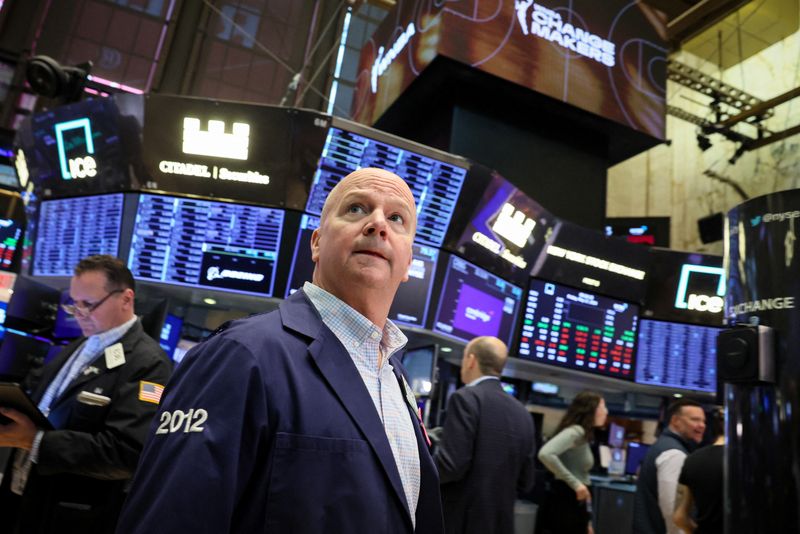By Medha Singh and Lewis Krauskopf
NEW YORK (Reuters) -Nvidia's plan to split its stock after the stunning rise in the chipmaker's share price could lure more interest from retail investors while potentially paving the way for the company's inclusion in the Dow Jones Industrial Average.
Nvidia shares were soaring 10% on Thursday afternoon after the company announced a 10-for-one stock split as part of a blockbuster quarterly report included its revenue and forecast coming in above analyst estimates.
Nvidia, which has become the poster child of investor enthusiasm for artificial intelligence, is the latest U.S. megacap company to unveil a stock split in recent years, including Amazon.com (NASDAQ:AMZN), Alphabet (NASDAQ:GOOGL) and Tesla (NASDAQ:TSLA). Nvidia itself executed a four-for-one split in mid 2021.
For Nvidia, the third-largest U.S. company by market value, the stock split could spark more interest from individual or retail investors, analysts said. The chipmaker's shares have already more than doubled so far in 2024.
Although a split alone does not change a stock's valuation, market analysts said the lowered per-share value of the stock woos individual investors, who tend to trade in smaller lots due to their limited funds in comparison to institutional investors, who have deeper pockets.
"The stock split is probably the biggest catalyst to keep attracting retail flows," said Marco Iachini, senior vice president at Vanda Research.
Nvidia's lead in the AI boom already has made it the most popular stock among individual investors over the past year. The stock is the highest weight in the average retail trading portfolio at 9.3%, followed by Apple (NASDAQ:AAPL) at 9.2% and the SPDR S&P 500 ETF (NYSE:SPY) at 7.8%, Vanda said in a note issued on Wednesday. A year ago, Nvidia made up 4.2% of the average portfolio.
More recently, retail traders' interest in the stock has slowed.
The latest weekly data shows a five-day rolling sum of retail-trader inflows into Nvidia stood at $278.3 million, down from a peak of $576.8 million in March, according to Vanda.
While many retail investors can buy shares on a fractional basis, reducing the need for a stock's price to be lower, not all such investors have that access, said Ben Laidler, global markets strategist at digital brokerage eToro. That made Nvidia's share price "an increasing obstacle," Laidler said. The stock was last trading at around $1,040.
Still, while Nvidia's split, effective June 7, "should appeal to retail investors ... the value of the business won’t have actually changed," said Dan Coatsworth, investment analyst at AJ Bell.
"The value of someone’s investment is completely unaffected," Coatsworth said.
In an "FAQ" document about the stock split, Nvidia said: "Given the significant appreciation of the company’s share price in recent years, the stock split is intended to make stock ownership more accessible to employees and investors." The company offered no further comment beyond its statements announcing the split.
STOCK SPLIT OUTPERFORMANCE
Companies that announce stock splits have tended to outperform the market. Those announcing splits have seen their shares rise an average of 25.4% over the next 12 months versus an 11.9% rise for the S&P 500, according to an analysis from BofA Global Research from February.
But a stock split alone is unlikely to overcome the host of other factors that can sway stocks. Shares of Amazon and Alphabet fell sharply in 2022 even though the companies both announced splits during the year, as surging interest rates weighed on stocks broadly.
S&P 500 companies have executed 31 stock splits since 2020, according to data from Howard Silverblatt, senior index analyst at S&P Dow Jones Indices.
That is far fewer than occurred during the early 2000s and late 1990s.
DOW IN SIGHT
In Nvidia's case, its split could make the stock more manageable for inclusion in the blue-chip Dow Jones Industrial Average. The 30-member Dow is a price-weighted index, so Nvidia's current price would make it twice the size of the largest weight in the Dow currently.
The split would reduce Nvidia's price to about $104 as of Thursday's price. That would make it the 21st-biggest stock in the Dow, just behind Merck and ahead of Walt Disney (NYSE:DIS). Nvidia is the third-biggest stock in the market cap-weighted S&P 500.
Similar speculation about Dow inclusion followed Amazon's split in 2022. Amazon was added to the Dow earlier this year.
"Nvidia certainly checks all the boxes to eventually become a Dow component: great reputation, history of sustained growth, interest to investors, and its sector representation of the broader market," said Art Hogan, chief market strategist at B. Riley Wealth, adding: "The $100 price would make the initial math easier."

An S&P Dow Jones Indices spokeswoman said it does not comment or speculate on index additions or deletions.
She referred to the Dow's methodology which says, "A stock typically is added only if the company has an excellent reputation, demonstrates sustained growth and is of interest to a large number of investors," and that the index committee "evaluates stock price when considering a company for inclusion."
